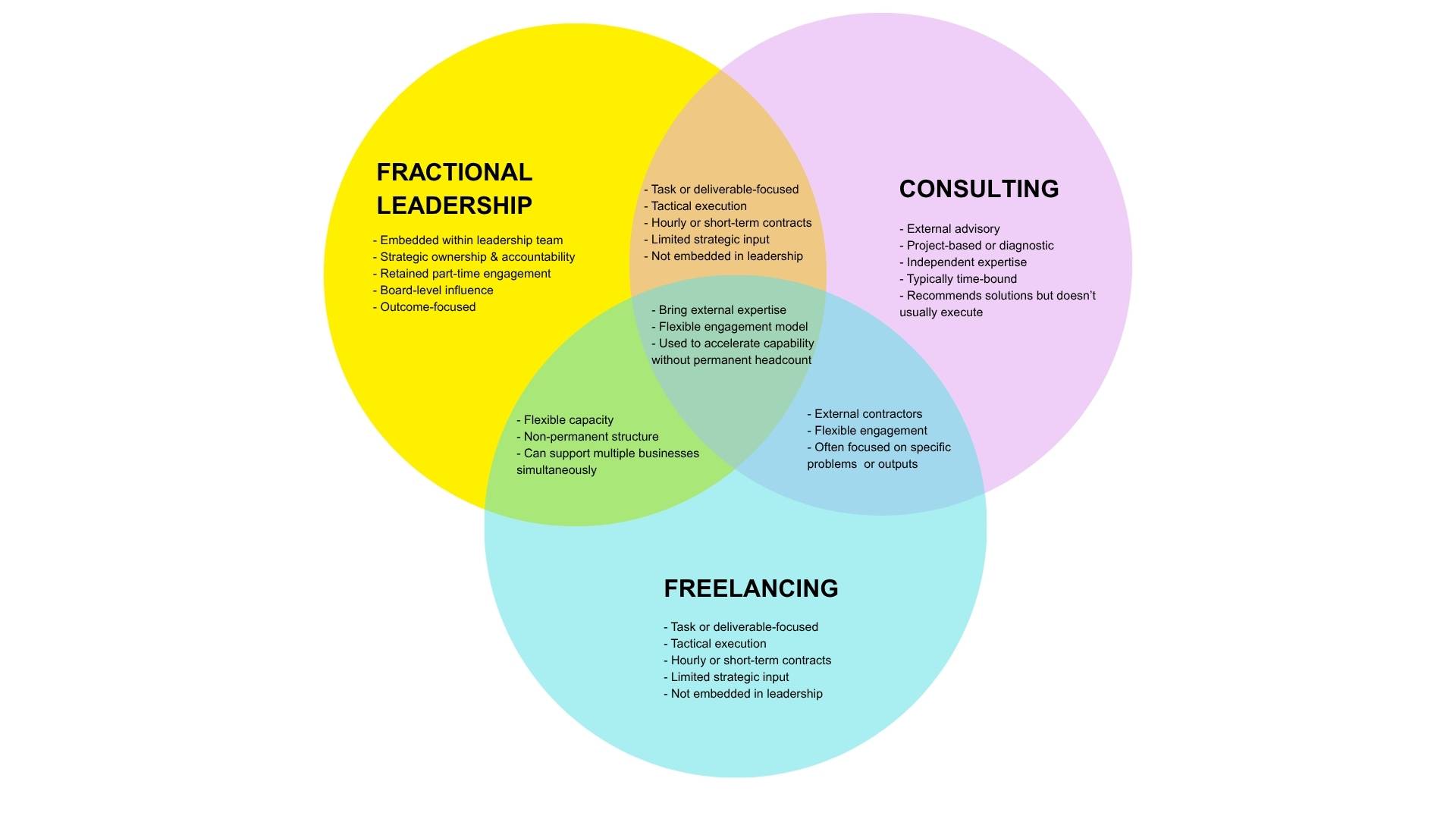Discover how fractional leadership is reshaping C-suites, offering senior-level impact without full-time overhead. A strategic model for modern business.
Introduction — Why Fractional Leadership Is Reshaping the Modern C-Suite
Leadership models have always evolved in response to economic forces, organisational complexity, and workforce expectations. In the post-war decades, the dominant model was straightforward: senior executives were full-time, long-tenured employees, embedded in hierarchical structures. Leadership careers were linear, and companies built in-house teams to deliver every core function.
By the late 20th century, this model began to loosen. Globalisation, M&A activity, and the rise of professional service firms drove demand for interim executives — experienced leaders brought in on fixed contracts to steer companies through transition, turnaround, or leadership gaps. These interim roles offered flexibility and expertise, but were typically full-time and time-bound, focused on stabilisation rather than structural change.
Then came the 21st century. Digital transformation, venture capital-fuelled innovation, remote work, and economic shocks fundamentally changed how companies grow — and how leadership talent is deployed. Many businesses, particularly scale-ups, mid-tier firms, and PE-backed organisations, now face an uncomfortable reality: they need high-calibre strategic leadership, but they don’t always need (or can’t justify) full-time executive headcount. Traditional interim roles often prove too rigid, and consultancy models can lack embedded accountability.
This is the context in which fractional leadership has emerged — not as a passing trend, but as a strategic response to modern business dynamics.
Fractional leadership involves embedding a senior leader — typically at C-suite or function head level — into an organisation on a part-time, retained, or project-based basis. Unlike consultants who advise from the outside, or interims who temporarily fill a full-time seat, fractional leaders integrate with the leadership team, shape strategy, and drive delivery, all without the cost and commitment of a permanent executive hire.
The rise of fractional leadership is being accelerated by two parallel shifts:
- Business demand for agility — Companies need senior expertise at specific inflection points (growth, transformation, M&A, or turnaround), but not necessarily every day of the week.
- Executive career evolution — Many experienced leaders are opting for portfolio careers, blending fractional engagements, advisory roles, and project work, often for greater variety, autonomy, and impact.
While the model has gained prominence in North America’s tech sector, its adoption is now rapidly expanding in the UK and Europe across functions — from marketing and finance to operations, HR, technology, and transformation. For founders, CEOs, and investors, fractional leadership is becoming a core tool for accessing strategic capability at speed, without long-term overheads.
This article by Paul Mills, a Chartered Fractional CMO and Founder of VCMO, unpacks the model in depth. We’ll define what fractional leadership is (and isn’t), trace how it differs from consulting and interim models, and explore its advantages, drawbacks, and use cases. We’ll also look at how to prepare your organisation for fractional leaders, and why this model is set to become a permanent feature of modern executive teams.
Defining Fractional Leadership
Fractional leadership is a strategic engagement model that allows organisations to embed senior executives on a part-time, retained, or project basis — typically at C-suite or function head level. The defining characteristic is not the job title, but the depth of integration and the level of strategic influence the leader brings to the organisation.
Unlike consultants, who typically advise from the outside, or freelancers, who execute discrete tasks, fractional leaders operate as part of the leadership team. They participate in board meetings, shape strategic direction, mentor internal teams, and are accountable for outcomes — but they do so for a fraction of the time (and cost) of a full-time executive.
Fractional leadership sits at the intersection of three models:
- Executive leadership — bringing senior-level experience, strategic authority, and decision-making weight.
- Consulting — offering external perspective, flexibility, and specialised expertise.
- Portfolio careers — enabling seasoned executives to work across multiple organisations simultaneously.
This unique positioning makes fractional leaders particularly valuable during periods of inflection: when a company is scaling rapidly, entering new markets, professionalising internal functions, preparing for investment or exit, or navigating complex transformation. At these moments, strategic leadership is critical — but the business case for a full-time, permanent hire may not yet exist.
What Fractional Leadership Is Not
Because the term “fractional” has become fashionable, it’s often misused or misunderstood. To clarify, fractional leadership is not:
- A short-term “gig” or freelance arrangement.
- A purely advisory role with no operational involvement.
- An hourly or transactional engagement focused on execution.
- A lower-grade version of executive leadership.
- Confined to early-stage start-ups or specific sectors like tech.
A true fractional leader operates at leadership level, influencing strategy, aligning functions, and driving outcomes. The “fractional” refers to time commitment, not capability. In fact, many fractional leaders are highly experienced executives — often ex-CMOs, CFOs, CTOs, COOs, or CROs — who have chosen a portfolio career model after leading in corporate, scale-up, or PE environments.
How Fractional Engagements Typically Work
While every engagement is unique, fractional leadership usually follows a structured pattern:
- Defined Scope and Objectives: The business and the fractional leader agree on strategic priorities — such as building a marketing engine, professionalising finance, or leading transformation.
- Part-Time or Retained Basis: The leader works a set number of days per month (often 2–8), typically under a services agreement rather than an employment contract.
- Embedded Leadership Role: They join leadership meetings, direct internal teams, manage suppliers, and make decisions with executive authority — but remain independent.
- Strategic Impact Without Structural Drag: Once their objectives are achieved, engagements may scale down, shift to advisory, or transition to permanent leadership if needed.
This flexibility allows businesses to access exactly the level of senior capability they need, when they need it — without carrying the fixed cost, long hiring cycles, or organisational inertia of a full-time appointment.
Fractional Leadership: Myths vs Reality
As the model grows in popularity, several misconceptions have emerged. It’s important for CEOs, founders, and investors to distinguish between hype and reality. Here’s a quick overview.

“Fractional leadership isn’t a diluted version of the real thing — it’s a way of unlocking senior expertise exactly when and where it’s needed most. The best fractional leaders combine strategic clarity with operational precision, accelerating growth while transferring capability into the business. For CEOs and investors, that’s an incredibly powerful proposition.”
Rachael Wheatley – Chartered Fractional CMO, VCMO
Historical Evolution & Market Drivers
Fractional leadership is not a fleeting trend — it is the product of deep structural changes in how organisations access talent, deploy senior expertise, and adapt to increasingly dynamic markets. To understand why the model is gaining traction today, it helps to look back at how leadership hiring and workforce models have evolved over the past three decades.
The Traditional Leadership Model: Stability and Permanence
For much of the 20th century, senior leadership roles were built on a foundation of long-term employment, linear career progression, and clear organisational hierarchies. Leaders were typically hired full-time, expected to spend years — sometimes decades — within the same organisation, rising through the ranks before reaching the C-suite.
In this model:
- Leadership was seen as a permanent fixture, not a flexible resource.
- Organisations built internal leadership pipelines and invested heavily in long-tenured executives.
- Strategy was formulated in annual cycles, and organisational change was comparatively slow.
This model worked well in relatively stable economic environments. But as markets globalised and technology accelerated, the cracks began to show.
The 1990s–2000s: The Rise of Outsourcing and Interim Executives
The first major shift came in the 1990s and early 2000s, as companies embraced outsourcing, offshoring, and interim executive roles to gain flexibility. Interim leaders were often parachuted in to cover maternity leave, manage turnaround situations, or lead short-term transformation programmes.
While this provided agility, interim roles remained full-time, time-limited assignments, often replicating traditional C-suite positions temporarily rather than rethinking their structure. Consulting also flourished during this period, with firms offering strategic advice externally — but without embedding inside the business.
Fractional leadership borrows some traits from both these models but differs in one crucial respect: it is designed for continuity, integration, and strategic contribution on a part-time basis, not just short-term crisis response.
The 2010s: Digital Acceleration and the Fragmentation of Expertise
The 2010s brought a step-change. Digital transformation, global competition, and the proliferation of marketing channels created new levels of complexity for leadership teams. Suddenly, no single leader could credibly hold deep expertise across every domain.
Businesses began to rely on specialist contractors, consultants, and agencies for execution. However, this created its own problems:
- Strategic fragmentation — multiple agencies pulling in different directions.
- Leadership gaps — especially in SMEs that couldn’t justify multiple full-time senior hires.
- Slower decision-making — as strategic leadership was outsourced or diluted.
It became clear that businesses needed strategic leaders who could flex in and out of the organisation, providing integrated leadership without the fixed cost of another permanent C-suite position.
The 2020s: Economic Volatility, Remote Work, and Portfolio Careers
The final accelerant came in the late 2010s and early 2020s, with three interlinked forces:
- Economic volatility — from Brexit to the pandemic — made permanent senior hiring less appealing for many mid-market firms and scale-ups.
- The rise of remote and hybrid work broke down geographic hiring constraints, enabling executives to support multiple companies concurrently.
- Portfolio careers gained traction among senior leaders seeking variety, autonomy, and flexibility after years in corporate roles.
These forces combined to make fractional leadership not just possible, but strategically attractive. Companies could now access top-tier expertise more flexibly, and experienced executives could structure their careers across multiple engagements, blending fractional leadership with advisory, consulting, or board roles.
A Strategic Response to a New Market Reality
Fractional leadership emerged as a structural response to permanent complexity:
- Businesses need senior leadership, but not always full-time.
- Strategy must evolve quickly, but without losing depth or accountability.
- Senior talent is abundant, but increasingly unwilling to be tied to one employer.
In many ways, fractional leadership represents the natural next step in the evolution of work: a shift from ownership of talent to access to capability — embedded, strategic, and adaptive.

“Fractional leadership isn’t a fad — it’s a structural response to complexity, volatility, and the changing expectations of senior talent.”
Ruth Napier – Chartered Fractional CMO, VCMO
Defining the Modern Fractional Leadership Model
Despite its rapid rise, fractional leadership remains widely misunderstood. Some mistake it for consulting, others see it as glorified freelancing, and many assume it’s relevant only to startups. In reality, fractional leadership represents a distinct, structured model of senior engagement — one that combines strategic authority with flexibility, embedding seasoned leaders directly into businesses on a part-time basis.
At its core, fractional leadership is the practice of engaging a senior executive — typically C-suite or equivalent — on a part-time or limited-term basis to lead a critical function within the business. Unlike consultants, who advise externally, or freelancers, who deliver defined tasks, fractional leaders are embedded within the leadership team. They sit at the strategic table, influence decision-making, and are accountable for outcomes — but without the permanence or cost of a full-time hire.
Fractional leaders are typically experienced operators with deep functional expertise, often gained through decades in senior roles. Many operate portfolio careers that blend fractional mandates with advisory, coaching, or project work. What unites them is their ability to provide board-level leadership with agility — stepping into a business to stabilise, accelerate, or professionalise a function during a critical stage of growth or change.
Key Characteristics of Fractional Leadership
To draw a clear line between fractional leaders and other external support models, it’s useful to consider their defining characteristics:
- Embedded, not external — Fractional leaders operate as part of the leadership team, participating in executive meetings, shaping strategy, and leading teams.
- Strategic remit — They own strategic direction and execution oversight for their function (e.g. marketing, finance, product), rather than offering isolated advice or deliverables.
- Part-time engagement — Typically between 1–3 days per week, structured through a retained services agreement rather than an employment contract.
- Outcome accountability — They are responsible for delivering tangible commercial and strategic outcomes, not just recommendations.
- Flexible duration — Engagements are designed around business need — from a few months to several years — and can scale up or down as the business evolves.
- Portfolio career model — Many fractional leaders work with multiple organisations simultaneously, enabling cross-pollination of ideas and best practices.
- High-calibre expertise — Most fractional leaders are former senior executives, often Chartered or otherwise accredited, bringing proven leadership experience.
- Bridge role — They often act as the connective tissue between the CEO, board, and operational teams, aligning strategy and execution.
This embedded, accountable, and strategic nature is what differentiates fractional leadership from other flexible talent models. A fractional CFO may redesign financial structures and oversee reporting cadence. A fractional CMO may define the go-to-market strategy and build marketing infrastructure. A fractional CTO may architect digital transformation while mentoring internal teams. Each brings executive-level capability at a fraction of the cost and commitment of a permanent role.
Typical Career Profiles of Fractional Leaders
Fractional leaders are rarely early-career professionals. Most have operated in senior leadership positions for 15–25+ years, often across multiple sectors. Common backgrounds include:
- Former C-suite executives seeking more variety, autonomy, or portfolio careers.
- Senior functional leaders (e.g. Marketing Directors, CFOs, CTOs) stepping out of corporate roles.
- Experienced interim executives who prefer embedded, longer-term part-time mandates.
- Entrepreneurs or ex-founders leveraging their commercial experience across multiple businesses.
They bring not only subject-matter expertise but also the pattern recognition that comes from navigating multiple business models, markets, and growth stages.
When Businesses Typically Engage Fractional Leaders
The fractional model is not confined to any one company size or sector. However, there are common scenarios where it proves especially valuable:
- Early-stage scaleups needing senior leadership but unable to justify full-time overheads.
- Mid-tier businesses hitting growth plateaus and requiring strategic uplift.
- Large enterprises managing transformation or needing targeted functional leadership without restructuring.
- Private equity-backed firms undergoing rapid buy-and-build strategies where leadership bandwidth is stretched.
- Organisations in transition (e.g. post-M&A, leadership departures, pre-exit preparation) requiring stabilising leadership.
In each case, the fractional leader acts as a catalyst — bringing strategic clarity, experienced oversight, and flexible capacity to address high-stakes challenges quickly.

Types of Fractional Leadership Roles
Fractional leadership is not confined to a single discipline. While the role of the Fractional CMO has gained significant traction in recent years, the model is increasingly being applied across multiple domains — from finance and technology to operations and people strategy. Each fractional leader brings board-level expertise, embedded part-time within the organisation, but tailored to a specific functional need.
1. Fractional CEO
Some scaling businesses bring in a seasoned CEO on a fractional basis to guide the company through critical transitions, such as restructuring, pre-exit planning, or international expansion. Fractional CEOs often work alongside founders, providing leadership coaching, strategic direction, and investor-facing credibility without permanently replacing the founder at the helm.
2. Fractional CFO
One of the earliest and most established fractional models. A Fractional Chief Financial Officer brings financial rigour, scenario planning, fundraising expertise, and governance. They are particularly common in early-stage scaleups preparing for Series A/B, or mid-market businesses undergoing M&A, where experienced financial leadership is needed but not yet affordable full-time.
3. Fractional COO
A Fractional Chief Operating Officer focuses on operational discipline — improving processes, supply chains, delivery capability, and scalability. Many founder-led companies hit a point where operational complexity outpaces internal capability. A fractional COO embeds structure, efficiency, and operational KPIs without hiring a permanent senior operator too early.
4. Fractional CTO / CIO
In technology-driven businesses, Fractional Chief Technology Officers or Chief Information Officers play a crucial role in digital transformation, architecture decisions, cybersecurity posture, and technical team leadership. They are often engaged to accelerate development, oversee vendor relationships, or manage complex IT roadmaps without committing to a full-time hire.
5. Fractional CHRO / CPO
The Fractional Chief Human Resources Officer (CHRO) or Chief People Officer (CPO) focuses on talent strategy, culture building, leadership development, and workforce planning. As companies scale, having senior people leadership — even a few days per month — can help shape culture, recruitment strategy, and retention far earlier than traditional models would allow.
6. Fractional CMO
The Fractional Chief Marketing Officer is one of the most visible roles within the fractional leadership ecosystem. They bring strategic marketing leadership, brand clarity, and growth discipline — aligning marketing with commercial goals. Their popularity has grown rapidly due to the strategic impact of marketing, the shortage of senior talent, and the flexibility the model offers.
Learn more in our article: What is a Fractional CMO?
7. Fractional CRO / CSO
Fractional Chief Revenue Officers or Chief Sales Officers focus on commercial strategy, sales enablement, and go-to-market execution. They often work closely with Fractional CMOs to ensure marketing and sales are aligned, supporting pipeline development, revenue operations, and expansion strategies.
The Advantages of Fractional Leadership
The appeal of fractional leadership lies in its ability to combine senior-level impact with commercial flexibility. For many organisations, especially those in growth, transformation, or transition phases, it offers a pragmatic route to leadership excellence without the fixed overheads or hiring risk of permanent appointments. Below are the core advantages.
1. Access to Top-Tier Talent, Sooner
Hiring a full-time senior leader — whether a CMO, CFO, or COO — can take months and requires significant financial commitment. Fractional leaders can typically onboard within weeks, bringing hard-won expertise from multiple sectors and situations. This enables businesses to access board-level strategic capability earlier in their journey, accelerating growth and avoiding leadership gaps.
2. Commercial Flexibility Without Sacrificing Quality
Fractional leadership allows companies to engage senior talent on a part-time, retainer, or project basis, aligning investment with current business needs. This model makes it possible to secure the same calibre of leadership you’d expect from a £150k–£250k+ full-time executive — at a fraction of the cost, and without long-term contractual obligations.
3. Strategic Focus and Objectivity
Because fractional leaders are not embedded in internal politics or legacy structures, they bring a fresh, objective lens to strategic decision-making. They are often brought in with clear mandates — such as repositioning a brand, building scalable operations, or preparing for investment — and are therefore less prone to distraction by internal noise.
4. Speed and Agility in Execution
Fractional leaders are typically highly experienced operators. They’ve solved similar challenges many times before and can hit the ground running, diagnosing problems and delivering strategies without lengthy onboarding. Their limited time forces clarity and focus — every meeting and decision has to count.
5. Stronger Governance and Professional Standards
For investors and boards, fractional leadership introduces rigour and governance at critical moments. Whether it’s a CFO bringing financial discipline ahead of a funding round, or a CMO sharpening the GTM narrative, fractional leaders bring frameworks, benchmarks, and external accountability that strengthen board confidence.
6. Knowledge Transfer and Capability Uplift
Fractional leaders don’t just deliver outcomes — they leave a legacy. By mentoring teams, professionalising functions, and embedding repeatable processes, they ensure that internal capability is strengthened, not bypassed. This makes them particularly valuable in founder-led or early-stage businesses, where internal teams may be strong executors but lack senior leadership exposure.
7. Reduced Hiring Risk
Hiring the wrong senior leader can be extremely costly, both financially and culturally. Fractional leadership provides a low-risk way to test leadership fit before committing to a permanent hire. It can also act as an interim bridge, maintaining momentum while a longer search takes place.
8. Scalable Model for Growth
Fractional leadership can scale up or down as business needs evolve. A company might begin with a fractional CFO one day per week during pre-seed, expand their remit during Series A, and then transition to a full-time leader post-IPO. This flexibility allows leadership capacity to grow in line with business maturity, not ahead of it.

“From a CFO’s perspective, fractional leadership provides senior-level impact without the fully loaded, fixed recurring cost burden of a full-time hire. It’s a future-focussed, commercially agile way to bring in strategic expertise, sharpen decision-making, and accelerate value creation — all while maintaining financial flexibility”
Rob Nicholls - Fractional CFO & Board Advisor, Rob Nicholls Consulting
When to Hire a Fractional Leader
Not every business challenge calls for a full-time senior hire. In fact, many inflection points in a company’s journey are best served by fractional leadership — where strategic expertise is needed, but the scope, budget, or time horizon doesn’t justify a permanent role. The key is recognising these moments early and bringing in the right fractional leader with a clearly defined mandate.
Typical scenarios include:
- Rapid Growth Without Senior Leadership - Many scale-ups reach a tipping point where operational complexity outpaces leadership capacity. A fractional leader can bring immediate structure, focus, and strategic clarity without waiting months for a full-time executive search.
- Strategic Transformation or Repositioning - Whether pivoting to a new market, reshaping the operating model, or integrating acquisitions, transformation demands seasoned strategic oversight. Fractional leaders are often brought in to provide this during defined change programmes.
- Interim Gaps in the Leadership Team - If a C-suite executive leaves abruptly, or if a critical leadership role remains vacant during a recruitment process, a fractional leader can ensure momentum doesn’t stall. They can stabilise teams, lead key initiatives, and hand over seamlessly when the permanent hire arrives.
- Pre-Funding or Exit Preparation - Investor due diligence places significant scrutiny on leadership capability and strategic clarity. Fractional leaders can sharpen the business narrative, strengthen governance, and professionalise functions ahead of a funding round or sale.
- Project-Based Strategic Initiatives - Some businesses bring in fractional leaders for targeted programmes — for example, developing a market expansion strategy, restructuring a marketing function, or overhauling financial systems. These are strategic sprints, not open-ended engagements.
- Testing Leadership Needs Before Committing to Full-Time - Fractional engagements are also a powerful way to test what kind of senior leadership is truly required. Businesses often discover that they don’t need a permanent executive immediately — or that the role they thought they needed actually looks quite different in practice.
- Cost or Risk Constraints - For founder-led or investor-backed businesses, committing to a six-figure full-time salary can be commercially risky. Fractional leaders offer board-level expertise at a lower cost, reducing financial exposure while still delivering strategic value.
Ultimately, the best time to engage a fractional leader is when the business requires strategic leadership to unlock growth or manage change — but doesn’t need, or cannot justify, a full-time appointment. In these moments, fractional leaders act as force multipliers: experienced operators who can embed quickly, focus on critical priorities, and deliver meaningful results on a flexible basis.

“Fractional leaders are most effective at inflection points — moments where clarity, pace, and senior judgement can change the trajectory of the business. Get the timing right, and their impact can be transformational.”
Lydia McClelland, Chartered Fractional CMO, VCMO
Benefits of Fractional Leadership for Employees and Teams
Fractional leadership is often viewed through a purely strategic or financial lens — focused on cost savings, flexibility, or access to senior expertise. But one of its most underestimated advantages lies inside the organisation: the positive impact on employees and teams. When executed well, fractional leadership can uplift internal capability, improve morale, and accelerate cultural maturity.
Here are the key ways this happens:
- Clarity and Direction: Teams often struggle not because of poor execution, but because of unclear strategy and inconsistent leadership. A fractional leader brings structured thinking and clear priorities, enabling teams to focus their energy where it matters most. This can dramatically reduce confusion, wasted effort, and frustration.
- Exposure to High-Calibre Leadership: Many SMEs and scale-ups cannot afford permanent senior leaders with 20+ years of experience. Fractional leaders give employees access to top-tier expertise — modelling strategic thinking, decision-making, and commercial rigour in real time.
- Skills Development and Mentorship: Fractional leaders are typically experienced coaches and mentors. They uplift teams by identifying skill gaps, sharing frameworks, and developing individuals through hands-on collaboration. This often leads to measurable capability improvement, without the need for expensive external training programmes.
- Cultural Maturity: Experienced fractional leaders often play a quiet but powerful role in raising cultural standards. By bringing external perspective and professional discipline, they can nudge teams towards higher accountability, cross-functional collaboration, and more commercially focused ways of working.
- Increased Confidence and Empowerment: When teams feel supported by seasoned leadership, they become bolder and more autonomous. Fractional leaders often act as a safety net — providing strategic guidance while giving teams the space to grow and execute.
- Fresh Thinking Without Disruption: Because fractional leaders are external yet embedded, they bring a valuable balance: fresh perspective without the cultural shock that sometimes accompanies permanent senior hires. They can challenge assumptions constructively, opening up new ways of thinking.
- Building Future Leaders: Many fractional leaders see part of their remit as leaving the team stronger than they found it. By nurturing internal talent, they help businesses build sustainable leadership pipelines — reducing future dependency on external hires.
For founders and investors, this internal uplift has strategic implications. It can reduce long-term recruitment costs, improve retention of key employees, and create a more self-sufficient organisation capable of scaling sustainably.

“The best fractional leaders don’t just deliver strategy — they grow people. They act as catalysts for professional maturity inside the organisation, leaving behind stronger teams and clearer processes.”
Drawbacks and Limitations of Fractional Leadership
Fractional leadership offers many advantages, but it’s not a universal solution. Like any operating model, it comes with trade-offs and limitations that business leaders must understand to make informed decisions. Recognising these limitations early helps ensure engagements are structured for success.
Here are the key considerations:
- Limited Time Availability - By definition, fractional leaders are not full-time employees. Their involvement is structured around a set number of days or hours each month. This can be highly effective for strategic work, but may present challenges if your business expects constant day-to-day availability or rapid response to operational issues.
- Scope and Expectation Management - Some organisations make the mistake of expecting fractional leaders to cover the remit of a full-time executive in a fraction of the time. This can lead to overload, blurred priorities, or unmet expectations. Clear scope definition and alignment with leadership teams are essential from the outset.
- Integration with Existing Culture - While fractional leaders often bring valuable external perspective, they are still outsiders. Cultural alignment takes deliberate effort — both from the fractional leader and the business. Without structured onboarding and leadership buy-in, they can remain on the periphery rather than becoming an integral part of the team.
- Knowledge Transfer Risks - Because engagements are often shorter or part-time, there’s a risk that critical knowledge remains with the fractional leader rather than being fully embedded internally. This is particularly true if the engagement ends suddenly or lacks a clear transition plan.
- Potential for Role Ambiguity - In some organisations, staff may be uncertain about the authority, decision rights, or long-term presence of a fractional leader. This can cause hesitation or misalignment, especially if communication from the CEO or board is unclear.
- Dependence on the Right Fit - Not all fractional leaders are the same. The success of the model hinges on hiring someone with the right mix of strategic capability, cultural compatibility, and communication skills. A poor match can be disruptive — just like a poor full-time hire.
- Communication Challenges Across Distributed Teams - If the business operates across multiple time zones or relies on asynchronous communication, part-time involvement can make coordination more complex. Strong processes and clear communication rhythms are vital to avoid friction.
- Transition & Continuity Gaps - If a fractional leader is brought in to solve a critical problem but there is no plan for what happens after their engagement ends, the organisation can experience a leadership vacuum. Fractional models work best when part of a deliberate, staged approach to building internal capability or transitioning to permanent leadership.
Read more in our article: Top Reasons to Not Hire a Fractional CMO

“Fractional leadership isn’t a magic wand. Its success depends on clear expectations, cultural fit, and structured onboarding. When treated as a shortcut to avoid proper strategic investment, it can falter just like any poorly defined leadership role.”
Dan Gwalter - Fractional Executive Coach, No-Nonsense Leadership
Which Companies Are Using Fractional Leadership (and in Which Sectors)
Fractional leadership is no longer a niche practice confined to start-ups or cost-conscious SMEs. It is being embraced across a spectrum of organisational types and sectors, from early-stage ventures through to large enterprises, as part of a deliberate strategy to access senior expertise with agility and precision.
Early-Stage and Scale-Up Businesses
Start-ups and early-stage scale-ups are often the earliest adopters of fractional models. These businesses typically operate with lean teams and finite capital but face complex strategic decisions at pace — such as entering new markets, professionalising operations, or preparing for investment.
Fractional leaders provide the strategic horsepower required to build foundations for growth without locking in the cost of a full-time executive. Common fractional roles include CFOs to professionalise financial governance, CMOs to define go-to-market strategies, and COOs to bring operational discipline.
Typical sectors:
- Technology & SaaS (e.g. B2B platforms, fintech, healthtech)
- Life Sciences & Biotech (e.g. pre-Series A/B firms needing commercial leadership)
- Professional Services (e.g. niche consultancies scaling client acquisition)
- Creative & Media (e.g. agencies building structured growth engines)
Mid-Tier and Private Equity-Backed Businesses
For mid-sized companies — often turning over £5m–£50m — fractional leadership offers a way to unlock transformation without slowing down. These organisations frequently encounter inflection points such as acquisitions, geographic expansion, or leadership transitions.
Private equity investors increasingly view fractional leadership as a value creation lever, enabling portfolio companies to access C-suite calibre talent quickly during high-impact phases. Fractional CMOs, CFOs, and CTOs are often brought in to accelerate integration, optimise commercial strategy, or build scalable operating models.
Typical sectors:
- Manufacturing & Engineering (e.g. modernising marketing and operations)
- Healthcare & MedTech (e.g. scaling internationally)
- Financial Services & Fintech (e.g. growth-stage firms needing strategic marketing or regulatory leadership)
- Specialist B2B Services (e.g. logistics, legal tech, recruitment)
Large Corporates and Enterprises
While less common, some large organisations are strategically adopting fractional models to fill leadership gaps quickly, inject external perspective, or pilot new ventures without the bureaucracy of permanent hires.
Typical use cases include transformation projects, innovation initiatives, or situations where internal leadership bandwidth is stretched. Fractional leaders often operate as embedded transformation catalysts, working alongside senior teams to shape strategy and accelerate delivery.
Typical sectors:
- Financial Services (e.g. digital transformation programmes)
- Pharmaceuticals & Life Sciences (e.g. commercialisation of niche assets)
- Retail & Consumer Goods (e.g. innovation units or D2C growth initiatives)
- Energy & Infrastructure (e.g. sustainability transitions, ESG leadership)
International Companies Entering the UK or EMEA
A growing number of international firms use fractional leadership to establish a strategic foothold in new markets. Rather than making a permanent senior hire immediately, they bring in experienced fractional leaders who understand the UK/European landscape, regulatory frameworks, and cultural nuances.
Fractional CMOs, COOs, and General Managers can act as bridge roles, establishing brand presence, shaping go-to-market strategies, and setting up local teams before transitioning to permanent leadership.
Typical sectors:
- US SaaS & Tech firms entering the UK market
- Asia-Pacific manufacturers seeking European distribution
- Life sciences firms expanding clinical and commercial operations
Key Takeaway: Fractional leadership is not confined to a single company size, sector, or maturity stage. Its versatility lies in being strategically deployed at moments of change — whether that’s scaling up, professionalising, transforming, or expanding into new markets.
“Fractional leadership is now part of the strategic playbook for ambitious organisations. From early-stage ventures to mature enterprises, it gives leaders the flexibility to access senior capability exactly when and where it’s needed — without unnecessary structural drag.”

Preparing Your Organisation for Fractional Leadership
Embedding a fractional leader is not simply a contractual decision; it’s an organisational readiness exercise. To maximise the value of fractional leadership, companies need to create the right strategic, cultural, and operational conditions for success. Unlike a consultant or freelancer, a fractional leader will be embedded into your leadership team — so preparation matters.
1. Clarify Your Strategic Priorities
Before engaging a fractional leader, it’s essential to articulate the business objectives you expect them to influence. This goes beyond “needing marketing help” or “improving operations.” You should be able to clearly define:
- The strategic challenge you’re solving (e.g. stalled growth, scaling internationally, post-acquisition integration).
- The commercial outcomes you want to achieve (e.g. increased pipeline velocity, improved gross margins, enhanced investor confidence).
- The time horizon for impact (e.g. 6–12 months to reshape strategy, 90 days to stabilise operations).
Fractional leaders thrive when their mandate is specific, outcome-oriented, and commercially grounded. A vague brief leads to vague results.
2. Align Leadership and Board Expectations
Fractional leadership sits at the intersection of executive authority and external perspective. To avoid friction, senior stakeholders — including founders, board members, and department heads — must align on:
- The scope of decision-making authority the fractional leader will hold.
- How they will interact with existing leaders and teams.
- Success criteria, both qualitative (e.g. clarity of strategy, cultural fit) and quantitative (e.g. revenue, pipeline, margin, retention).
Misalignment here can create tension between internal leaders and the fractional appointment, undermining their effectiveness. A brief alignment session with the leadership team before engagement can save months of inefficiency later.
3. Define the Engagement Model
Fractional leadership is deliberately flexible — but it still requires structure. You should establish clear parameters around:
- Time commitment: How many days per month are required, and what cadence works best (e.g. 1–2 days per week vs sprint-based involvement).
- Operating rhythm: Participation in leadership meetings, board updates, or strategy days.
- Engagement type: Is this a retained fractional role, project-based engagement, or a bridge to permanent leadership?
- Integration with teams: Clarity on reporting lines, decision rights, and collaboration norms.
A well-defined engagement model ensures that the fractional leader can operate with authority and efficiency — rather than spending their time navigating ambiguity.
4. Prepare Your Team Culturally
Introducing a fractional leader can be a cultural shift, particularly for businesses that have never worked with senior external talent in a leadership capacity. Success depends on internal teams understanding and embracing the model.
Practical steps include:
- Communicating clearly to staff why the fractional leader is joining and what role they will play.
- Positioning the engagement as a strategic accelerator, not a threat to existing roles.
- Encouraging openness to fresh perspectives and external challenge.
Fractional leaders often bring a calm, objective lens to existing problems, helping teams move past legacy habits. This can be powerful — but only if teams are receptive.
5. Ensure Access to Data, Systems, and People
Fractional leaders move quickly — but only if they have access to the information and tools they need. Before they start, ensure that:
- Relevant performance data, dashboards, and reports are accessible from day one.
- Key systems (CRM, financial platforms, project tools) have appropriate user access in place.
- Internal stakeholders are briefed and ready for initial onboarding sessions.
Think of it like onboarding a senior executive — but accelerated. The quicker the fractional leader gains a clear view of the landscape, the faster they can deliver strategic value.
6. Treat Them as Part of the Leadership Team
Fractional leaders are not “hired hands”; they operate at board or executive level. To get the best from them:
- Include them in leadership meetings and strategy discussions.
- Encourage open collaboration between internal leaders and the fractional appointment.
- Avoid relegating them to tactical firefighting — their highest value is in strategic thinking, prioritisation, and commercial alignment.
When treated as a peer within the leadership team, fractional leaders can drive transformation with focus and pace.
“Fractional leadership delivers additional agility & extraordinary value, when the organisation is ready to integrate senior external talent into its leadership fabric. Open and honest engagement, real partnering and an operational readiness make the difference between a good engagement and a transformational one.”
Rob Nicholls - Fractional CFO & Board Advisor, Rob Nicholls Consulting

When to Hire a Fractional Leader
Fractional leadership is most effective at strategic inflection points — moments when your organisation needs senior expertise but doesn’t require (or can’t justify) a full-time appointment. Typical scenarios include:
- Early scale-up: You’ve achieved product–market fit and need to build structured growth strategies, but a full-time C-suite hire is premature.
- Transformation or turnaround: The business is repositioning, restructuring, or integrating post-M&A and requires experienced leadership to steer the change.
- Leadership gaps: An unexpected departure or maternity leave has left a strategic function leaderless. Fractional appointments can bridge the gap without losing momentum.
- Investor preparation: Ahead of funding rounds or exit events, fractional leaders bring commercial rigour and narrative clarity to impress investors and boards.
- Strategic projects: Launching a new market, product, or commercial model where specialist leadership is required for a defined period.
In each case, fractional leaders bring board-level capability with precision and flexibility, accelerating progress without the cost and commitment of a permanent hire. The key is to align the timing with strategic need, not simply headcount availability.
Read more in our article: Signs Your Business Needs a Fractional CMO
Conclusion: A Strategic Shift in How Leadership is Accessed
Fractional leadership represents more than just a flexible resourcing model — it reflects a structural shift in how organisations access senior expertise. As markets become more volatile, business models more fluid, and talent expectations more portfolio-based, the traditional notion of leadership as a permanent, full-time appointment is being re-evaluated.
For founders, CEOs, and investors, this evolution offers significant advantages. By engaging fractional leaders, businesses can embed experienced, commercially minded executives precisely when and where they are needed. They gain the strategic oversight and leadership maturity typically associated with full-time C-suite hires, but with greater agility, lower fixed cost, and faster impact.
For seasoned executives, fractional leadership represents a new career paradigm — one that blends strategic depth with portfolio variety, offering autonomy, focus, and the ability to make a tangible difference across multiple organisations.
However, fractional leadership is not a panacea. Success depends on selecting the right individual, structuring clear mandates, and integrating them effectively into the leadership team. When done well, fractional leaders act not as outsiders, but as trusted strategic partners — shaping direction, unlocking growth, and accelerating change.
The rise of fractional leadership signals a more dynamic, outcome-driven approach to building senior teams. It’s not about replacing permanent roles altogether, but about deploying leadership talent with the same precision and flexibility that modern businesses apply to every other strategic resource.
Suggested Further Reading
The Rise of Fractional Marketing Leadership
What is a Fractional Chief Marketing Officer
What Are the Key Considerations When Hiring a Fractional CMO?
About VCMO
VCMO is a UK-based provider of fractional marketing services, supporting B2B SMEs—ranging from funded scale-ups to mid-tier and private equity-backed businesses—through key moments of growth and transformation. Its Chartered Fractional CMOs and SOSTAC® certified planners embed strategic marketing leadership into organisations navigating product launches, new market entry, acquisitions, and leadership gaps.
What’s a Rich Text element?
The rich text element allows you to create and format headings, paragraphs, blockquotes, images, and video all in one place instead of having to add and format them individually. Just double-click and easily create content.
- By following these tips, you can make sure you’re noticed on LinkedIn and start building the professional connections you need to further your career.
-

Static and dynamic content editing
A rich text element can be used with static or dynamic content. For static content, just drop it into any page and begin editing. For dynamic content, add a rich text field to any collection and then connect a rich text element to that field in the settings panel. Voila!
How to customize formatting for each rich text
Headings, paragraphs, blockquotes, figures, images, and figure captions can all be styled after a class is added to the rich text element using the "When inside of" nested selector system.


Ready to take your marketing to the next level? Let us help you get there.
Subscribe to Our Newsletter
Fractional Edge is our montly newsletter sharing expert opinion on the latest trends in fractional leadership, curated marketing content from leading sources, VCMO events, and much more. Subscribing is quick — just add your name and email.











.jpg)





